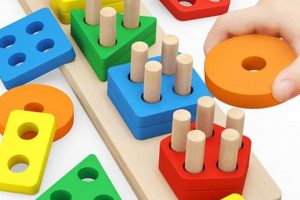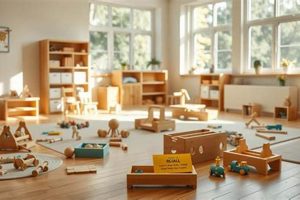Child-directed materials designed for open-air play and learning, emphasizing natural elements and hands-on exploration, exemplify this category. Examples include gardening tools sized for small hands, nature exploration kits with magnifying glasses and bug viewers, or loose parts like planks and logs for building and imaginative play.
These playthings foster independence, creativity, and a deeper connection with the natural world. They encourage gross motor skill development, problem-solving, and scientific observation through unstructured play. Rooted in the educational philosophy of Maria Montessori, this approach emphasizes self-directed learning and experiential discovery. Historically, the Montessori method has always valued the outdoors as an extension of the classroom, recognizing its potential for multi-sensory learning and holistic development.
This exploration delves into the various types of these enriching materials, offering guidance on selection, implementation, and the numerous developmental advantages they offer children.
Tips for Utilizing Outdoor Learning Materials
Maximizing the benefits of these materials requires careful consideration of the child’s developmental stage, interests, and the available outdoor environment. The following tips offer guidance for creating engaging and enriching outdoor experiences.
Tip 1: Prioritize Natural Materials: Opt for items crafted from natural materials like wood, metal, or cotton. These materials offer a richer sensory experience and promote a connection with nature.
Tip 2: Embrace Open-Ended Play: Choose materials that can be used in multiple ways, encouraging creativity and problem-solving. Loose parts like branches, stones, and fabric scraps offer endless possibilities for imaginative play.
Tip 3: Consider the Child’s Developmental Stage: Select materials appropriate for the child’s age and abilities. Younger children may benefit from simpler tools and activities, while older children can engage with more complex projects.
Tip 4: Create a Dedicated Outdoor Space: Designate a specific area for outdoor learning, whether it’s a small balcony or a large backyard. This provides a sense of order and encourages focused exploration.
Tip 5: Observe and Follow the Child’s Lead: Allow children to choose their own activities and explore at their own pace. Observe their interests and gently guide their learning without interrupting their flow.
Tip 6: Incorporate Gardening Activities: Provide child-sized gardening tools and a dedicated space for planting and caring for plants. This fosters responsibility, an understanding of life cycles, and a connection to the natural world.
Tip 7: Facilitate Nature Exploration: Equip children with tools like magnifying glasses, bug viewers, and binoculars to encourage close observation of the natural world. Nature walks and scavenger hunts can further enhance these experiences.
By implementing these strategies, caregivers and educators can create enriching outdoor environments that foster children’s holistic development and cultivate a lifelong love of learning and nature.
These tips provide a foundation for establishing an effective outdoor learning environment. The following section will explore specific examples of materials and activities suitable for different age groups and interests.
1. Natural Materials
Natural materials are fundamental to Montessori outdoor toys, fostering a deeper connection with the environment and offering rich sensory experiences. Unlike plastic counterparts, natural materials like wood, bamboo, cotton, and wool engage multiple senses. The varied textures of wood, the scent of cedar, the softness of cotton, and the coolness of stone provide sensory input that stimulates cognitive development and grounds children in the physical world. This tactile exploration encourages fine motor skill refinement and an appreciation for natural variations. Choosing toys crafted from natural materials aligns with the Montessori philosophy of respecting the environment and promoting sustainable practices.
The inherent qualities of natural materials contribute significantly to child development. Wooden blocks, for instance, offer a satisfying weight and warmth absent in plastic equivalents. A wooden climbing frame weathers over time, demonstrating the natural processes of aging and decay. These experiences enhance a child’s understanding of the life cycle of materials and foster respect for the natural world. Furthermore, natural materials are often more durable and safer than synthetic options, free from harmful chemicals and microplastics. Real-life examples include wooden balance boards, cotton play cloths, wicker baskets for collecting natural treasures, and gardening tools with wooden handles.
Prioritizing natural materials in outdoor play supports children’s sensory development, environmental awareness, and overall well-being. While the initial investment in natural material toys may be higher, their longevity, safety, and educational value represent a significant long-term benefit. The emphasis on natural materials within the Montessori approach underscores the importance of connecting children with the natural world, fostering respect for the environment, and promoting sustainable practices. This connection is crucial for developing environmentally responsible individuals and nurturing a lifelong appreciation for nature.
2. Open-Ended Play
Open-ended play is a cornerstone of the Montessori philosophy, particularly in outdoor environments. It allows children to direct their own learning experiences, fostering creativity, problem-solving skills, and a deeper understanding of the world around them. Unlike structured activities with predetermined outcomes, open-ended play provides opportunities for exploration, experimentation, and self-discovery. This approach empowers children to develop independence, resilience, and a lifelong love of learning.
- Child-Directed Activities
In open-ended play, children choose their own activities and set their own pace. A pile of loose parts, such as sticks, stones, and leaves, can become a building project, a pretend cooking scenario, or a scientific investigation. This freedom of choice allows children to follow their interests and develop intrinsic motivation. The absence of prescribed instructions encourages creative thinking and resourcefulness.
- Developing Problem-Solving Skills
Open-ended materials, like building blocks or a water table, present children with challenges that require problem-solving. Balancing blocks to create a stable structure or figuring out how to redirect water flow encourages critical thinking and spatial reasoning. These experiences build confidence and resilience as children learn to overcome obstacles independently.
- Social Interaction and Collaboration
Outdoor environments designed for open-ended play provide opportunities for social interaction and collaboration. Children may work together to build a fort, create a mud kitchen, or engage in dramatic play scenarios. These shared experiences foster communication, negotiation, and teamwork skills, preparing children for social situations in later life.
- Connection with Nature
Open-ended play in natural settings encourages a deeper connection with the environment. Exploring a garden, observing insects, or building with natural materials fosters an appreciation for the natural world and a sense of wonder. These experiences contribute to a child’s holistic development and promote environmental awareness.
These facets of open-ended play contribute significantly to the effectiveness of Montessori outdoor toys. By providing children with the freedom to explore, experiment, and create, these materials facilitate holistic development and cultivate a lifelong love of learning. The emphasis on child-directed activities, problem-solving, social interaction, and connection with nature aligns seamlessly with the core principles of the Montessori philosophy, fostering independence, creativity, and a deep appreciation for the world around them.
3. Child-led Exploration
Child-led exploration forms the foundation of Montessori education, particularly within outdoor environments. It empowers children to direct their learning experiences, fostering independence, intrinsic motivation, and a deeper understanding of the natural world. This approach contrasts sharply with traditional, adult-directed learning, where a prescribed curriculum dictates the pace and content of education. With child-led exploration, the child’s innate curiosity and interests guide the learning process, making it more engaging and meaningful. Outdoor spaces equipped with Montessori-aligned materials provide the ideal setting for this type of exploration.
- Following the Child’s Interests
Observing a child’s interests and allowing them to pursue those interests is paramount. A child fascinated by insects might spend hours observing ants, while another might be captivated by building structures with natural materials. Respecting these individual interests and providing appropriate resources, such as magnifying glasses or loose parts, allows for deep, self-directed learning.
- Freedom to Choose and Experiment
Providing children with a range of open-ended materials and the freedom to choose how to use them is essential. A set of wooden blocks can become a tower, a bridge, or a pretend animal enclosure, depending on the child’s imagination and chosen activity. This freedom to experiment fosters creativity, problem-solving skills, and a sense of ownership over the learning process. For example, a child might experiment with different ways to balance a plank on a log, developing an intuitive understanding of physics principles.
- The Role of the Adult as Observer and Guide
Adults play a crucial role in facilitating child-led exploration, not as instructors, but as observers and guides. They provide a safe and stimulating environment, offer gentle guidance when needed, and model respect for the child’s autonomy. Intervening only when necessary allows children to develop problem-solving skills and build confidence in their abilities. For instance, an adult might offer a suggestion if a child is struggling with a particular task, but they would refrain from taking over and completing the task for the child.
- Developing Independence and Self-Reliance
Child-led exploration fosters independence and self-reliance by empowering children to make choices and take responsibility for their learning. Choosing which activity to pursue, how to use the available materials, and how long to engage with a particular task builds self-confidence and decision-making skills. This autonomy extends beyond the play environment, equipping children with the skills necessary to navigate challenges and make informed choices in various aspects of their lives.
These facets of child-led exploration highlight the essential role of Montessori outdoor toys in supporting children’s holistic development. By providing opportunities for self-directed learning, experimentation, and connection with nature, these materials cultivate a lifelong love of learning and foster essential skills such as creativity, problem-solving, and independence. The carefully designed outdoor environment becomes a space where children can freely explore, discover, and grow, guided by their innate curiosity and supported by thoughtfully chosen materials.
4. Sensory Engagement
Sensory engagement is integral to a child’s development, and Montessori outdoor toys provide a rich and diverse platform for this crucial exploration. Unlike sterile indoor environments, the outdoors offers a multitude of sensory experiencesthe feel of grass beneath bare feet, the scent of blooming flowers, the sound of rustling leaves, the sight of flitting butterflies. Montessori-aligned outdoor materials capitalize on these natural opportunities, encouraging children to engage deeply with the world through their senses. This direct sensory experience fosters cognitive development, emotional regulation, and a profound connection with nature.
- Tactile Exploration
Outdoor play naturally encourages tactile exploration. Children digging in soil, manipulating sand, or collecting smooth stones experience a variety of textures, temperatures, and weights. Montessori materials like wooden blocks, textured balls, and natural fiber ropes further enhance these experiences, refining fine motor skills and developing sensory acuity. Handling a rough-hewn wooden block contrasts sharply with the smooth surface of a polished stone, expanding a child’s tactile vocabulary and understanding of material properties.
- Auditory Stimulation
Natural soundscapes provide a calming and stimulating backdrop for outdoor play. The rustling of leaves, the chirping of birds, and the gentle patter of rain offer a rich tapestry of auditory input. Montessori outdoor toys can further enrich this soundscape. Wind chimes create gentle melodies, while pouring water from one container to another demonstrates variations in pitch and volume. These experiences enhance auditory discrimination and appreciation for the nuances of sound.
- Visual Exploration
The vibrant colors of flowers, the varied patterns of leaves, and the changing hues of the sky provide endless opportunities for visual exploration outdoors. Montessori materials often incorporate natural colors and textures, enhancing visual stimulation without overwhelming a child’s senses. A simple wooden puzzle with images of natural objects, or a set of colorful scarves for dancing in the wind, encourages visual tracking, color recognition, and an appreciation for the beauty of the natural world.
- Nature’s Scents and Smells
The natural world is filled with a variety of scents, from the sweet fragrance of flowers to the earthy aroma of damp soil. These olfactory experiences stimulate the limbic system, influencing emotions and memory. Outdoor Montessori activities, such as gardening or exploring a herb garden, provide opportunities to engage with these natural scents. The distinct smell of lavender, the pungent aroma of mint, and the earthy scent of freshly turned soil enrich a child’s sensory palette and deepen their connection with nature.
These multifaceted sensory experiences, facilitated by thoughtfully designed Montessori outdoor toys, contribute significantly to a child’s holistic development. By engaging all senses, these materials foster cognitive growth, emotional well-being, and a deep appreciation for the natural world. This emphasis on sensory exploration aligns perfectly with the Montessori philosophy, recognizing the crucial role of sensory input in building a strong foundation for learning and development. The outdoor environment, rich in sensory opportunities, becomes an extension of the Montessori classroom, providing a dynamic and engaging space for exploration, discovery, and growth.
5. Real-world Connections
Real-world connections are fundamental to the efficacy of Montessori outdoor toys. These connections bridge the gap between abstract concepts and tangible experiences, fostering deeper understanding and intrinsic motivation. Unlike traditional toys that often promote fantasy-based play, Montessori materials emphasize activities rooted in practical life skills and natural exploration. This approach grounds learning in reality, making it more relevant and engaging for children. A child using a child-sized watering can to tend a garden, for example, gains a practical understanding of plant care and the importance of water for growth. Building a birdhouse provides insights into construction, animal habitats, and the local ecosystem. These real-world connections cultivate a sense of purpose and responsibility, empowering children to contribute meaningfully to their environment.
The practical significance of this approach is evident in the development of essential life skills. Children learn to problem-solve, collaborate, and take initiative through activities like gardening, composting, or building with natural materials. These experiences foster independence, self-reliance, and a sense of accomplishment. Furthermore, real-world connections nurture a deeper appreciation for nature and environmental stewardship. Children who actively participate in caring for plants, observing wildlife, or composting organic waste develop a sense of interconnectedness with the natural world and an understanding of their role in protecting it. Examples of this connection include using real tools for gardening, observing natural weather patterns with a weather vane, or collecting and categorizing natural specimens like leaves and rocks.
Cultivating real-world connections through outdoor Montessori experiences offers significant long-term benefits. Children develop a strong foundation for scientific understanding, practical life skills, and environmental awareness. This approach instills a lifelong love of learning and a sense of responsibility towards the natural world, contributing to the development of well-rounded, engaged individuals. Addressing the potential challenge of limited access to natural outdoor spaces, educators and caregivers can create miniature versions of these experiences within urban settings using container gardens, window boxes, and accessible natural materials. The key is to prioritize hands-on, purposeful activities that connect children to the tangible world around them, fostering a deeper understanding of their environment and their place within it.
Frequently Asked Questions
This section addresses common inquiries regarding Montessori-aligned outdoor materials and their role in child development.
Question 1: What distinguishes Montessori outdoor toys from conventional outdoor play equipment?
Emphasis on natural materials, open-ended play, and child-led exploration distinguishes these materials. Conventional play equipment often prioritizes prescribed activities, limiting creativity and self-discovery. Montessori materials, conversely, encourage children to direct their play, fostering problem-solving and independence.
Question 2: Are Montessori outdoor toys suitable for all ages?
Materials cater to various developmental stages. Infants benefit from sensory exploration with natural textures like grass and sand. Toddlers engage with simple tools and activities like pouring water or digging. Older children utilize more complex materials for building, gardening, and scientific observation. Selection should align with the child’s current abilities and interests.
Question 3: How can these materials be implemented in limited outdoor spaces like balconies or small yards?
Even small spaces accommodate core principles. Vertical gardening, container planting, and a curated selection of loose parts like pebbles, shells, and small wooden blocks offer rich opportunities for exploration. Prioritizing natural materials and open-ended play remains crucial regardless of space constraints.
Question 4: What is the role of adult involvement in outdoor Montessori play?
Adults serve as facilitators, preparing the environment and observing children’s engagement. Intervention occurs only when necessary, preserving the child’s autonomy and fostering problem-solving skills. Guidance focuses on demonstrating proper tool use, ensuring safety, and encouraging respect for the environment.
Question 5: How do these materials benefit children’s development beyond physical skills?
Benefits extend to cognitive, social, and emotional development. Problem-solving, creativity, and scientific thinking are fostered through open-ended exploration. Social skills develop through collaborative projects and dramatic play. Emotional regulation and a sense of calm are nurtured through interaction with nature.
Question 6: How can one ensure the safety of children using outdoor Montessori materials?
Prioritizing natural, non-toxic materials mitigates exposure to harmful chemicals. Regular inspection of materials for wear and tear ensures safe usage. Adult supervision remains essential, particularly for younger children, to prevent accidents and guide safe practices with tools and equipment.
Understanding these key aspects allows for informed selection and effective implementation of Montessori-aligned outdoor materials, maximizing developmental benefits for children.
Further exploration of specific material recommendations and activity ideas follows in the next section.
Conclusion
Materials designed for open-air Montessori learning offer significant advantages for child development. Prioritizing natural elements, child-directed exploration, and sensory engagement fosters holistic growth, encompassing physical, cognitive, social, and emotional domains. Open-ended play with these materials cultivates creativity, problem-solving skills, and a deeper connection with the natural world. From simple gardening tools to complex building structures, the versatility of these resources supports a wide range of learning experiences across different age groups and developmental stages.
Investing in these enriching materials represents an investment in a child’s future, nurturing a lifelong love of learning, an appreciation for nature, and the development of essential life skills. Thoughtful selection and implementation of these materials, guided by the principles of Montessori education, can transform outdoor spaces into dynamic learning environments that empower children to explore, discover, and grow.







